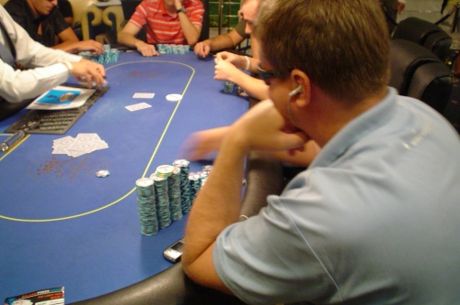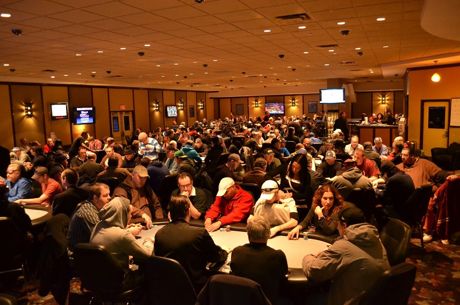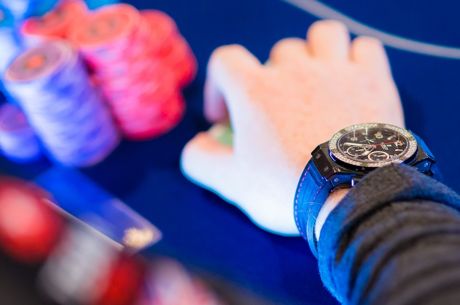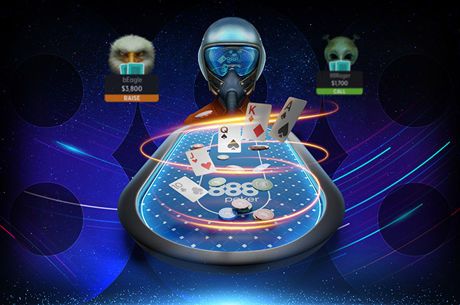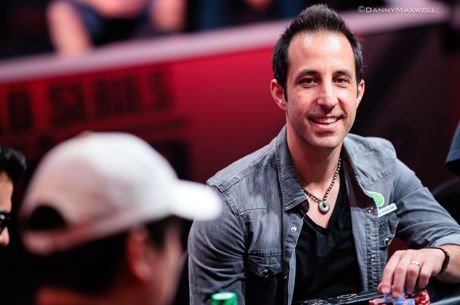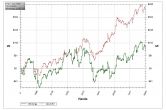A Multi-Way Hand: Raise for Value or Call to Keep Players In?
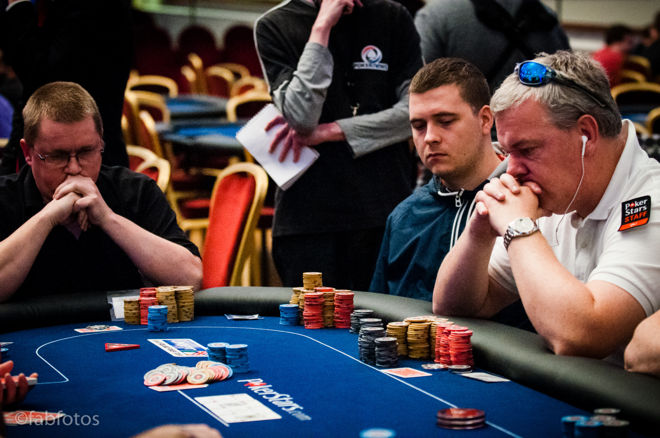
Not long ago while playing at UKIPT Edinburgh in the £770 buy-in Main Event, I came across a situation where I had to decide between raising a strong hand for value or calling and keeping players in behind. In fact, I had to decide this three times in the same hand.
We were at the 150/300/25 level. Starting stacks were 25,000 and everyone involved in this hand had a bit more than that.
It all began with a raise to 700 from an early position player. I called in middle position with 4x4x, then two players with position on me called and the big blind called as well. The five of us then watched the flop come QxJx4x with three different suits.
Two Good Options
It checked to the initial raiser who continuation bet 1,500 into a pot of nearly 4,000. This was a recreational player who would probably continue with AxQx, KxQx, QxJx, AxAx, KxKx, and sometimes Kx10x and 10x9x. Of course this player would also continue with QxQx and JxJx.
The action was on me and my flopped bottom set. There is a very strong argument for my raising here based on getting value from that list of worse hands. It would be very hard for this player to fold AxQx, KxKx, or AxAx if the board were to complete without any obvious threat arising. And he will never get away from QxJx, even if I raise.
A benefit of raising at this point would be to shutout the three players behind from playing well with hands like Kx10x, 10x9x, Ax10x, Kx9x, and 10x8x. For example, the player on the button is going to be laid a price of 1,500 to win at least 7,000. If he holds a straight draw, with position, he’s almost guaranteed to play his hand well.
Calling, however, does allow the initial raiser to continue to bet later streets with KxQx-type hands, or improve his hand to two pair. Calling also lets a player behind draw very slim with a Qx9x- or KxJx-type hand.
In retrospect I should have raised to build a pot against a strong range (remember the initial raiser is betting into four other people — not a sign of weakness on this board by any stretch). But thinking also about how the player on my direct left was a little steamed up from previous misadventures, I made a small mistake and called.
Good Problems
The aforementioned steamer called behind me and the button called as well.
We all already thought the initial raiser has a strong betting range. I believed for the player directly behind me to call, he couldn’t have a hand like 10x10x or Jx9x, steamed or not. The player probably had a queen. The player on the button, meanwhile, would be the one who could look to fill a gutshot for the price, so I took note to be wary of that player waking up if an 8x, 9x, 10x, Kx, or Ax were to appear.
In any case the turn was perfect — an offsuit 6x, making the board full rainbow.
The initial raiser bet again, this time 2,500 into 8,500. If I were to raise at this point, I felt my hand would be essentially face-up, even against poor or tilted hand readers. A raise would say I either have 4x4x or QxJx, and most players would be able to get away from KxQx and AxQx if not KxKx and AxAx. On the flop, I had called to keep in those behind. But on the turn, I called to keep the player pushing the action unsuspecting.
Of course by doing so I also was allowing the players behind me to realize what equity they may have held. Our steamer did call, but the button let his hand go (probably one of those 10x8x or Kx9x weak gutshots).
River Math
The river brought another 6x, making the board QxJx4x6x6x and improving me to fours full of sixes. Our undeterred leader bet 5,000, meaning this player had fired thrice into multiple players. I no longer thought he had KxQx or even AxQx.

To get value from the betting player’s range of QxJx, AxAx, and KxKx, I could have raised to 10,000. This would give him an incredible price to call that wouldn’t cost him his tournament life. But it would have me putting 10,000 at risk. Even though I had chips behind and we were in the tournament’s early stages, I was disinclined to dip too deeply into my stack.
I thought as well how if I called, I could still win 10,000 — that is, if the steaming player behind had QxJx all along or decided with AxQx that he didn’t want to fold. Furthermore, should I call the 5,000 and see JxJx or QxQx from the player who has been pushing the action, I would have endured only a grazing wound in a spot where many no-limit players suffer the death knell (i.e., an opponent flopping set-over-set).
Given the combination of these pressures — keeping in mind I could get value from the player behind calling, and that I risked being behind if I were to raise — I decided to call one more time.
Our steamer took a long time but eventually called as well. As it turned out, he was giving me a bonus of 5,000, as my full house was best. The bettor claimed to have had QxJx.
Raising Peril
The player who was betting throughout this hand essentially was representing a range that I could have raised for value on the flop or the turn, but that I couldn’t have on the river.
That’s why I consider the river the easiest choice of the three postflop streets. It is a clear example of three-way river dynamics — helpful to consider, because we aren’t as often able to practice.
The best way to start on this question of raising is to consider which hands are out there to get value from and what is the best route to do it. We won’t always get a perfect board run out like I did this hand, but we can hope to use hand reading to make the best choices.
Want to stay atop all the latest in the poker world? If so, make sure to get PokerNews updates on your social media outlets. Follow us on Twitter and find us on both Facebook and Google+!

